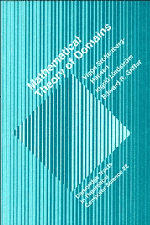Book contents
- Frontmatter
- Contents
- Preface
- Chapter 0 Preliminaries
- Part I Basic Theory
- Chapter 1 Fixed Points
- Chapter 2 Complete Partial Orders
- Chapter 3 Domains
- Chapter 4 Domain Equations
- Chapter 5 Topology
- Chapter 6 Representation Theory
- Chapter 7 A Universal Domain
- Part II Special Topics
- References
- Index of Symbols
- Index
Chapter 5 - Topology
Published online by Cambridge University Press: 05 June 2012
- Frontmatter
- Contents
- Preface
- Chapter 0 Preliminaries
- Part I Basic Theory
- Chapter 1 Fixed Points
- Chapter 2 Complete Partial Orders
- Chapter 3 Domains
- Chapter 4 Domain Equations
- Chapter 5 Topology
- Chapter 6 Representation Theory
- Chapter 7 A Universal Domain
- Part II Special Topics
- References
- Index of Symbols
- Index
Summary
Topology, or the theory of topological spaces, is a thoroughly developed and established branch of mathematics. Its concepts and results are used in almost all areas. In the introduction to his famous treatise General Topology (Kelley [1955]), Kelley states that he almost labelled it: “What every young analyst should know”. In fact, topology is useful in many areas not apparently related to analysis, such as logic and program semantics. As we shall see, Scott–Ershov domains viewed as topological spaces look quite different from the space of, say, real numbers.
The raison d'être of topological spaces is that the continuous functions live on them, that is continuity is a topological concept. More precisely, the topologies on spaces X and Y determine the continuous functions from X into Y. Conversely, given a class of functions from a set X into a set Y we may want to find topologies on X and on Y so that the functions that are continuous with respect to these make up the given class of functions. For example, we have already decided for good reasons which functions between domains are to be continuous. Scott has found a topology on domains for these functions, appropriately called the Scott topology. Ershov's concept of a domain was actually formalized as a topological notion, that is, a domain or, in his terminology, an f0-space is a topological space with certain strong properties (see Exercise 10.7.4).
- Type
- Chapter
- Information
- Mathematical Theory of Domains , pp. 114 - 135Publisher: Cambridge University PressPrint publication year: 1994

